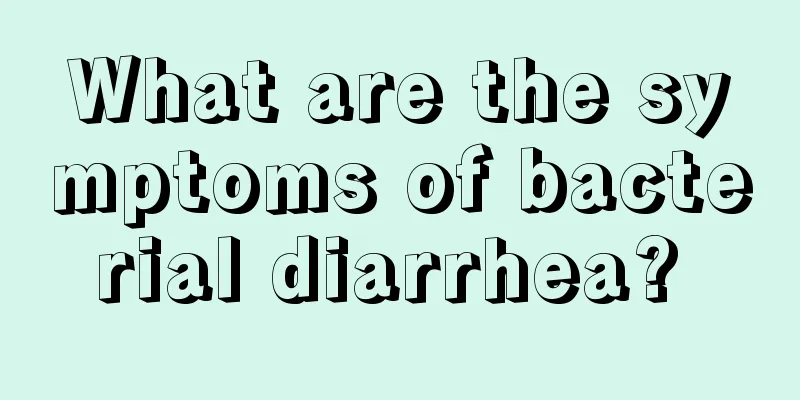What are the symptoms of bacterial diarrhea?

|
Bacterial diarrhea is a type of diarrhea, which can be divided into acute bacillary dysentery and chronic bacillary dysentery. In the case of acute bacillary dysentery, the patient will experience nausea, vomiting, abdominal pain, bloody stools, high fever, etc.; in the case of chronic bacillary dysentery, there are no special symptoms, but if it is not treated for a long time, it will cause purulent stools, etc. 1. Acute bacillary dysentery There are mainly systemic poisoning symptoms and digestive tract symptoms, which can be divided into four types: (1) Common type (typical): acute onset, moderate toxemia, chills, fever up to 39°C, fatigue, loss of appetite, nausea, vomiting, abdominal pain, diarrhea, and tenesmus. The patient first has watery stools, which turn into bloody stools after 1 to 2 days. The patient has dozens of bowel movements a day, with small amounts of stool and no significant water loss. It is often accompanied by hyperactive bowel sounds and left lower abdominal tenderness. The general course of the disease is 10 to 14 days. (2) Mild (atypical) systemic poisoning symptoms, abdominal pain, tenesmus, and tenderness in the left lower abdomen are not obvious. There may be low fever, mushy or watery stools mixed with a small amount of mucus, no pus or blood, and diarrhea frequency is generally less than 10 times a day. Microscopic examination of stool shows red and white blood cells, and culture shows the growth of Shigella dysenteriae, which can be used to distinguish it from acute enteritis. The general course of the disease is 3 to 6 days. (3) Severe case: More common in elderly, weak or malnourished patients. There are severe systemic poisoning symptoms and intestinal symptoms. The disease has an acute onset, high fever, nausea, vomiting, severe abdominal pain and tenderness in the abdomen (especially in the left lower abdomen), obvious tenesmus, bloody stools, frequent bowel movements, and even incontinence. The disease progresses rapidly, with obvious water loss, cold limbs, extreme exhaustion, and easy occurrence of shock. (4) Toxic type. This type is more common in children aged 2 to 7 years old with good physical fitness. The onset is acute, with obvious symptoms of systemic poisoning, high fever reaching over 40°C, patients with lethargy, pale complexion, cold limbs, weak breathing, skin patterns, repeated convulsions, drowsiness, and even coma, while the intestinal inflammatory reaction is extremely mild. According to clinical manifestations, it can be divided into shock type (with infectious shock as the main manifestation), brain type (with central nervous system symptoms as the main manifestation) and mixed type (with manifestations of both types, which is the most dangerous). This is due to the action of Shigella dysenteriae endotoxin and may be related to the specific constitution of some children. 2. Chronic bacillary dysentery Patients with bacillary dysentery may have repeated attacks or the disease may persist for more than 2 months, which may be related to improper treatment in the acute phase or the type of pathogenic bacteria (Flexerella infection can easily become chronic). It may also be related to poor general condition or chronic diseases in the local gastrointestinal tract. The main pathological changes are colon ulcerative lesions. Polyps may form at the edges of the ulcers. Scars are left after the ulcers heal, leading to intestinal stenosis. The classification is as follows: (1) Chronic latent type. The patient has a history of bacillary dysentery but no clinical symptoms. Stool culture is positive for pathogens, and sigmoidoscopy may reveal manifestations of bacillary dysentery such as mucosal inflammation or ulcers. (2) Chronic protracted type. Patients have a history of acute bacillary dysentery, which persists for a long time, with abdominal distension or long-term diarrhea, mucus, pus and blood in the stool, and long-term intermittent bacterial excretion, which is an important source of infection. (3) Acute attack of chronic type. The patient has a history of acute bacillary dysentery. The symptoms are no longer obvious after the acute phase. Factors such as cold and improper diet cause the symptoms to reappear, but they are milder than those in the acute phase. |
<<: What is the orthodontic process like?
>>: Does anemia affect the eyes?
Recommend
Who are the people most prone to body odor
Body odor is a disease that many of us find parti...
What is the best effect achieved after radiotherapy and chemotherapy for stage 2B cervical cancer
Most patients survive within 1-2 years, and those...
What is the matter with air conditioner frost? What is the matter with refrigerator frost?
Whenever it is hot in summer, people will choose ...
What to eat to prevent throat cancer
We should pay attention to diseases like laryngea...
Can disseminated prostate cancer be cured
Prostate cancer is one of the most common maligna...
What should I do if black spots appear on the oral mucosa?
As the most frequently used organ in our lives, o...
What to do if bladder cancer recurs two months after surgery
Bladder cancer is a treatable disease, but after ...
Effects of compound electrolyte injection
Compound electrolyte injection is a water and ele...
Is it good to drink boiled water before going to bed?
Now with the continuous improvement of people'...
How much do you know about the symptoms of rectal tumors?
Medical research shows that if the symptoms of re...
Is the tiger-striped colubrid snake poisonous?
Snakes are one of the animals that everyone disli...
What is the method of using a needle to clean the baby's nasal cavity?
The nostrils of a baby are very small and the bab...
What are the symptoms of advanced pancreatic cancer
Late-stage pancreatic cancer usually refers to pa...
Why does the bone in the left buttock hurt?
If you have bone pain in your left buttock, you n...
Apply gallnut and angelica root to the navel
Traditional Chinese medicine culture is profound ...









